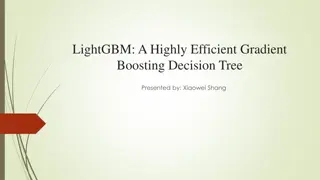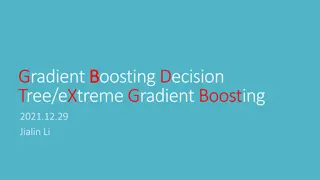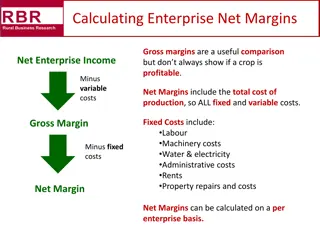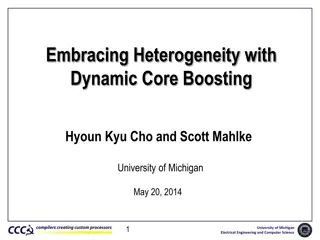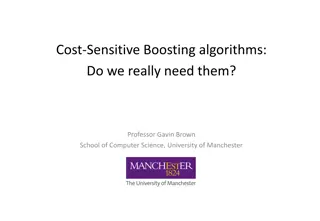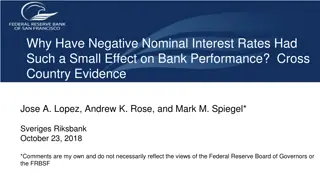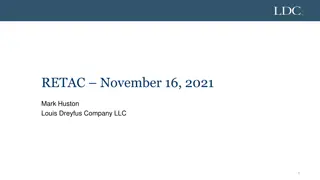
Boosting Approach to Machine Learning: Adaboost and Generalization Theorems
Learn about Adaboost, a powerful boosting algorithm that improves learning accuracy by creating challenge datasets. Explore its features, training error analysis, and generalization guarantees through theorems by Freund & Schapire. Discover how Adaboost is adaptive, fast, and grounded in theory.
Download Presentation

Please find below an Image/Link to download the presentation.
The content on the website is provided AS IS for your information and personal use only. It may not be sold, licensed, or shared on other websites without obtaining consent from the author. If you encounter any issues during the download, it is possible that the publisher has removed the file from their server.
You are allowed to download the files provided on this website for personal or commercial use, subject to the condition that they are used lawfully. All files are the property of their respective owners.
The content on the website is provided AS IS for your information and personal use only. It may not be sold, licensed, or shared on other websites without obtaining consent from the author.
E N D
Presentation Transcript
Boosting Approach to ML Perceptron, Margins, Kernels Maria-Florina Balcan 03/18/2015
Recap from last time: Boosting General method for improving the accuracy of any given learning algorithm. Works by creating a series of challenge datasets s.t. even modest performance on these can be used to produce an overall high-accuracy predictor. Adaboost one of the top 10 ML algorithms. Works amazingly well in practice. Backed up by solid foundations.
Adaboost (Adaptive Boosting) Input: S={(x1,?1), ,(xm,?m)}; weak learning algo A (e.g., Na ve Bayes, decision stumps) xi ?, ?? ? = { 1,1} + + For t=1,2, ,T Construct Dt on {x1, , xm} Run A on Dt producing ht:? { 1,1} Output Hfinal? = sign ?=1?? ?? + + + ht + + - - + - - - - - - D1 uniform on {x1, , xm} 1 ?] [i.e., D1? = Given Dt and ht set ??+1? =??? ?? e ??if ??= ??? ??+1? =??? ??+1? =??? e ???? ??? ?? ?? e??if ?? ??? ??=1 2ln 1 ?? ?? Dt+1 puts half of weight on examples xi where ht is incorrect & half on examples where ht is correct > 0
Nice Features of Adaboost Very general: a meta-procedure, it can use any weak learning algorithm!!! (e.g., Na ve Bayes, decision stumps) Very fast (single pass through data each round) & simple to code, no parameters to tune. Grounded in rich theory.
Analyzing Training Error Theorem ??= 1/2 ??(error of ? over ??) ??2 ?????????? exp 2 ? So, if ?,?? ? > 0, then ?????????? exp 2 ?2? The training error drops exponentially in T!!! 1 ?2log 1 ? To get ?????????? ?, need only ? = ? rounds Adaboost is adaptive Does not need to know ? or T a priori Can exploit ?? ?
Generalization Guarantees Theorem where ??= 1/2 ?? ??2 ?????????? exp 2 ? How about generalization guarantees? Original analysis [Freund&Schapire 97] H space of weak hypotheses; d=VCdim(H) ?????? is a weighted vote, so the hypothesis class is: G={all fns of the form sign( ?=1 ?? ?(?)) } ? Theorem [Freund&Schapire 97] ? ?,??? ? ????? + ? ?? ? T= # of rounds Key reason: VCd?? ? = ? ?? plus typical VC bounds.
Generalization Guarantees Theorem [Freund&Schapire 97] where d=VCdim(H) ?? ? ? ?,??? ? ????? + ? generalization error error train error complexity T= # of rounds
Generalization Guarantees Experiments showed that the test error of the generated classifier usually does not increase as its size becomes very large. Experiments showed that continuing to add new weak learners after correct classification of the training set had been achieved could further improve test set performance!!!
Generalization Guarantees Experiments showed that the test error of the generated classifier usually does not increase as its size becomes very large. Experiments showed that continuing to add new weak learners after correct classification of the training set had been achieved could further improve test set performance!!! These results seem to contradict FS 97 bound and Occam s razor (in order achieve good test error the classifier should be as simple as possible)! ? ?,??? ? ????? + ? ?? ?
How can we explain the experiments? R. Schapire, Y. Freund, P. Bartlett, W. S. Lee. present in Boosting the margin: A new explanation for the effectiveness of voting methods a nice theoretical explanation. Key Idea: Training error does not tell the whole story. We need also to consider the classification confidence!!
because it turned out to be increasing the margin of the classifier Boosting didn t seem to overfit (!) test error of base classifier (weak learner) test error train error Error Curve, Margin Distr. Graph - Plots from [SFBL98]
Classification Margin H space of weak hypotheses. The convex hull of H: ? ? ?? ? = ? = ?=1 ?? ?,?? 0, ?=1 ??= 1, ? ? Let ? ?? ? ,? = ?=1 ??= 1. ? ? ?? ?,?? 0, ?=1 The majority vote rule ?? given by ? (given by ??= ????(? ? )) predicts wrongly on example (?,?) iff ?? ? 0. Definition: margin of ?? (or of ?) on example (?,?) to be ??(?). ? ? ?? ? = ? ?? ?? = ??? ?? = ?? ?? ?=1 ?=1 ?:?= ?? ?:? ?? The margin is positive iff ? = ??? . See ?? ? = |? ? | as the strength or the confidence of the vote. Low confidence 1 -1 High confidence, correct High confidence, incorrect
Boosting and Margins Theorem:VCdim(?) = ?, then with prob. 1 ?, ? ??(?), ? > 0, d ln2? 1 ? + ln1 ? ? Pr ??? ? 0 Pr ??? ? ? + ? ?2 Note: bound does not depend on T (the # of rounds of boosting), depends only on the complex. of the weak hyp space and the margin!
Boosting and Margins Theorem:VCdim(?) = ?, then with prob. 1 ?, ? ??(?), ? > 0, d ln2? 1 ? + ln1 ? ? Pr ??? ? 0 Pr ??? ? ? + ? ?2 If all training examples have large margins, then we can approximate the final classifier by a much smaller classifier. Can use this to prove that better margin smaller test error, regardless of the number of weak classifiers. Can also prove that boosting tends to increase the margin of training examples by concentrating on those of smallest margin. Although final classifier is getting larger, margins are likely to be increasing, so the final classifier is actually getting closer to a simpler classifier, driving down test error.
Boosting and Margins Theorem:VCdim(?) = ?, then with prob. 1 ?, ? ??(?), ? > 0, d ln2? 1 ? + ln1 ? ? Pr ??? ? 0 Pr ??? ? ? + ? ?2 Note: bound does not depend on T (the # of rounds of boosting), depends only on the complex. of the weak hyp space and the margin!
Boosting, Adaboost Summary Shift in mindset: goal is now just to find classifiers a bit better than random guessing. Backed up by solid foundations. Adaboost work and its variations well in practice with many kinds of data (one of the top 10 ML algos). More about classic applications in Recitation. Relevant for big data age: quickly focuses on core difficulties , so well-suited to distributed settings, where data must be communicated efficiently [Balcan-Blum-Fine-Mansour COLT 12].
Interestingly, the usefulness of margin recognized in Machine Learning since late 50 s. Perceptron[Rosenblatt 57] analyzed via geometric (aka ?2,?2) margin. Original guarantee in the online learning scenario.
The Perceptron Algorithm Online Learning Model Margin Analysis Kernels
The Online Learning Model Example arrive sequentially. We need to make a prediction. Afterwards observe the outcome. For i=1, 2, , : Example ?? Phase i: Online Algorithm Prediction (??) Observe c (??) Mistake bound model Analysis wise, make no distributional assumptions. Goal: Minimize the number of mistakes.
The Online Learning Model. Motivation - Email classification (distribution of both spam and regular mail changes over time, but the target function stays fixed - last year's spam still looks like spam). - Recommendation systems. Recommending movies, etc. - Predicting whether a user will be interested in a new news article or not. - Add placement in a new market.
Linear Separators Instance space X = Rd Hypothesis class of linear decision surfaces in Rd. O X O X X O X X O O X w X X O h x = w x + w0, if ? 0, then label x as +, otherwise label it as - O X X O Claim: WLOG w0= 0. Proof: Can simulate a non-zero threshold with a dummy input feature ?0 that is always set up to 1. ? = ?1, ,?? ? = ?1, ,??,1 w x + w0 0 iff ?1, ,??,w0 ? 0 where w = ?1, ,??
Linear Separators: Perceptron Algorithm Set t=1, start with the all zero vector ?1. Given example ?, predict positive iff ?? ? 0 On a mistake, update as follows: Mistake on positive, then update ??+1 ??+ ? Mistake on negative, then update ??+1 ?? ? Note:?? is weighted sum of incorrectly classified examples ??= ??1??1+ + ?????? ?? ? = ??1??1 ? + + ?????? ? Important when we talk about kernels.
Perceptron Algorithm: Example Example: 1,2 1,0 + 1,1 + 1,0 1, 2 1, 1 + X - - - X X + + + Algorithm: ?1= (0,0) Set t=1, start with all-zeroes weight vector ?1. Given example ?, predict positive iff ?? ? 0. On a mistake, update as follows: Mistake on positive, update ??+1 ??+ ? Mistake on negative, update ??+1 ?? ? ?2= ?1 1,2 = (1, 2) ?3= ?2+ 1,1 = (2, 1) ?4= ?3 1, 2 = (3,1)
Geometric Margin Definition:The margin of example ? w.r.t. a linear sep. ? is the distance from ? to the plane ? ? = 0(or the negative if on wrong side) Margin of positive example ?1 ?1 w Margin of negative example ?2 ?2
Geometric Margin Definition:The margin of example ? w.r.t. a linear sep. ? is the distance from ? to the plane ? ? = 0(or the negative if on wrong side) Definition:The margin ?? of a set of examples ? wrt a linear separator ? is the smallest margin over points ? ?. + + + w + ?? + - ?? ++ - - + - - - - - -
Geometric Margin Definition:The margin of example ? w.r.t. a linear sep. ? is the distance from ? to the plane ? ? = 0 (or the negative if on wrong side) Definition:The margin ?? of a set of examples ? wrt a linear separator ? is the smallest margin over points ? ?. Definition:The margin ? of a set of examples ? is the maximum ?? over all linear separators ?. w + ? + - ? ++ - - + - - - - - -
Perceptron: Mistake Bound Theorem: If data has margin ?and all points inside a ball of radius ?, then Perceptron makes ?/?2mistakes. (Normalized margin: multiplying all points by 100, or dividing all points by 100, doesn t change the number of mistakes; algo is invariant to scaling.) + + + + w* ++ w* + + - - - - R - - - - -
Perceptron Algorithm: Analysis Theorem: If data has margin ?and all points inside a ball of radius ?, then Perceptron makes ?/?2mistakes. Update rule: Mistake on positive: ??+1 ??+ ? Mistake on negative: ??+1 ?? ? Proof: Idea: analyze ?? ? and ?? , where ? is the max-margin sep, ? = 1. Claim 1: ??+1 ? ?? ? + ?. (because ? ? ? ? ?) Claim 2: ??+1 (by Pythagorean Theorem) 2+ ?2. 2 ?? ??+1 ? After ? mistakes: ??+1 ? ?? (by Claim 1) ??+1 ? ? (by Claim 2) ??+1 ? ??+1 (since ? is unit length) ?? 2. ? ? So, ?? ? ?, so ?
Perceptron Extensions Can use it to find a consistent separator (by cycling through the data). One can convert the mistake bound guarantee into a distributional guarantee too (for the case where the ??s come from a fixed distribution). Can be adapted to the case where there is no perfect separator as long as the so called hinge loss (i.e., the total distance needed to move the points to classify them correctly large margin) is small. Can be kernelized to handle non-linear decision boundaries!
Perceptron Discussion Simple online algorithm for learning linear separators with a nice guarantee that depends only on the geometric (aka ?2,?2) margin. It can be kernelized to handle non-linear decision boundaries --- see next class! Simple, but very useful in applications like Branch prediction; it also has interesting extensions to structured prediction.







